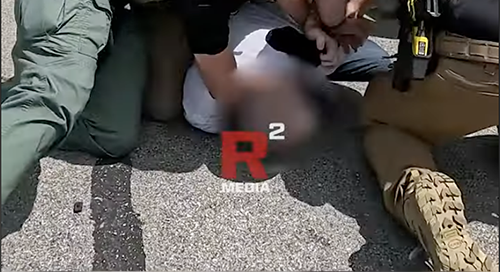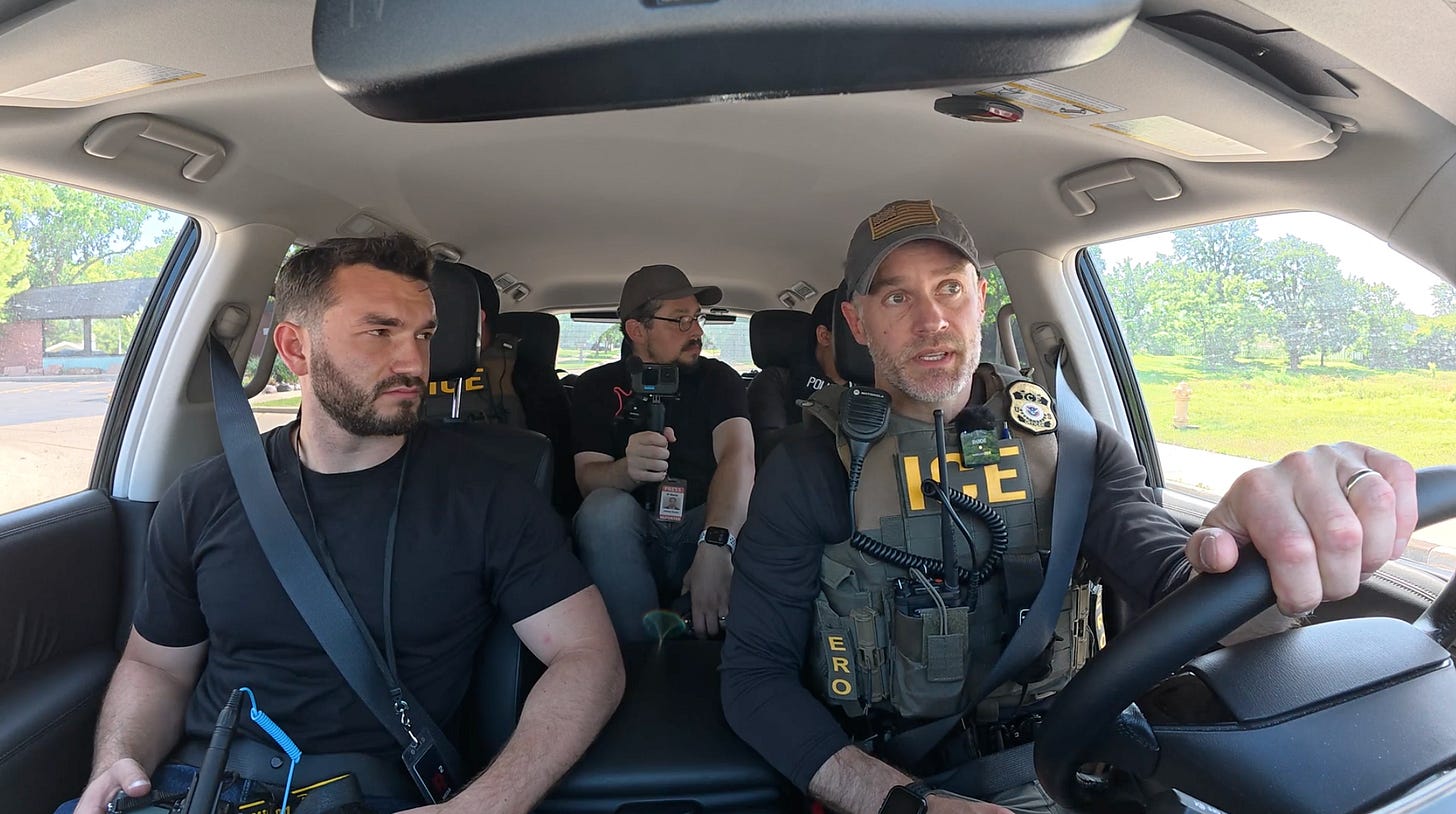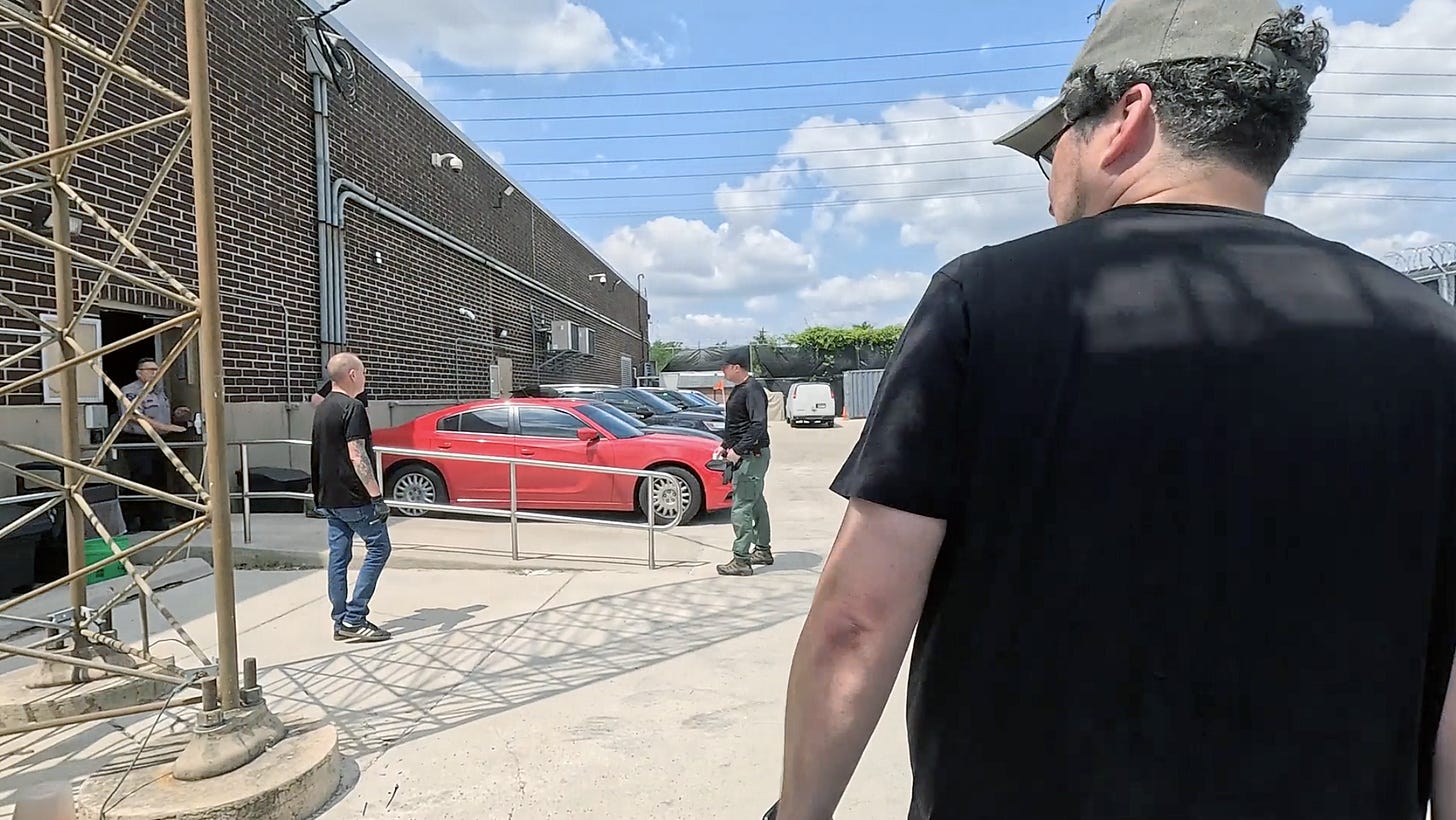Greetings from Kyiv, where Nathaniel and I are on assignment covering the war in Ukraine. We’ve only been here a few days after three hard days of travel and are still another day’s journey from the zero line. But more on that later.
Early last week, we were in Chicago, embedded with ICE’s field director on an arrest and given a tour of a processing/detention center. I’m not one to throw around the word “exclusive,” but we may be one of the few news outlets in the country given full access to one of ICE’s detention centers.
What we saw comes with a big disclaimer. We witnessed operations in Chicago. Many of the headlines making national news right now are coming out of Southern California and New York City. But in Chicago, we saw a department primarily focused on apprehending individuals with criminal records. What stood out: the arrest we were embedded on targeted a green card holder—a legal resident of the U.S., but not a citizen.
That morning started in the parking lot of a suburban police station. Local patrol cars rolled by slowly, honking playfully at families crossing the street. It was a quiet neighborhood. Slowly, the rest of the team began arriving. The FBI pulled up first.
“Where’s Homeland Security?” one ICE agent asked.
They arrived a few minutes later.
ICE was the lead agency on this arrest, but both the FBI and Homeland Security were supporting—part of a new directive under the Trump administration allowing other federal law enforcement agencies to assist with ICE field operations.
“I think the biggest misconception is that we’re somehow not real law enforcement, and somehow our officers don’t have the same authority as others do,” Sam Olson, head of the U.S. Customs and Immigration Enforcement Chicago field office, told us.
“Our people are federal law enforcement officers. We’re charged with enforcing the laws of the Immigration and Nationality Act. But we can also enforce federal criminal laws as well.”
We were told to expect a long wait. The 10 a.m. briefing ran through the target’s criminal history—strongarm robbery, resisting arrest, domestic abuse—and confirmed he was a legal permanent resident recently released from a three-year sentence. Agents had been surveilling him for several days, tracking his bus route, timing his morning walks, noting how long he lingered on the corner before heading inside. One agent flagged an older man—possibly a relative—who had stepped out and scanned the street, possibly on the lookout for ICE. There were two minor teenagers in the house. Agents had a 100-yard window between the bus stop and the front door. The plan was to arrest him in that gap, before he reached the house.
Unlike criminal law, this wasn’t about a new charge or a warrant issued by a judge. The suspect was being targeted under administrative law—a separate legal process that governs immigration enforcement. The warrant was signed by an ICE supervisor, not a judge. And that distinction matters.
Under administrative law, ICE can knock on a door. But they can’t enter without permission. No matter the charges or criminal history, unless they have a judicial warrant, they need consent to cross the threshold. It’s a legal boundary with real operational consequences.
That’s why ICE made the arrest on the street—out in public, where no entry was required. And it’s also why, in neighborhoods like this one, community organizations we visited were holding “know your rights” clinics—teaching residents what to say, what not to sign, and how to legally decline entry.
To be clear, this individual was a green card holder, not an undocumented immigrant. But the access we had gave us insight into how ICE operations work more broadly—including the arrests now making national headlines in other cities against undocumented individuals.
“Essentially each of the laws that we're enforcing on the administrative side do have a corresponding criminal charge on them.
But I mean, since we're usually not in the criminal enforcement realm—we're in the administrative enforcement realm—I think that's where the confusion is.
But just because it's an administrative arrest or an administrative warrant doesn't mean it holds any less burden of proof on our officers.
Officers need probable cause to arrest somebody for this—probable cause that they're here illegally. So that same standard applies just like if we were arresting somebody on a criminal charge.
That doesn't change.
If somebody is here, they might have committed a crime here, but if they're here in the country illegally, there is a statute against being here illegally.
There are statutes for if somebody was here illegally and then committed a crime and they're not a citizen, you could make them removable from the U.S. as well.
So, I mean, it's complicated.”
—Sam Olson, Deputy Director, ICE Chicago
After the briefing, we made the quick trip to the parking lot of a nearby shopping center where we would stage. The arresting agents were across a busy four-lane road, in position for the suspect. We were settling in for a long wait.
Then the radio cracked.
“We have eyes on the suspect.”
The arrest was happening early.
We jumped into gear and crossed the street. No sirens. When we arrived, the takedown was already underway. The suspect struggled. He shouted. Pulled back. ICE agents forced him to the ground and cuffed him on the sidewalk. A few minutes later, it was over.
You could hear the confusion in his voice. He repeated over and over that he was a legal resident, that he had status, that he had done nothing wrong. ICE agents confirmed that was true—but told him they had a warrant.
He then started talking about his medication after he was asked about his medical history. Agents agreed to retrieve it. Standard procedure we were told. We made the short trip to the other side of the block. We watched as they approached the house and knocked.
Then things got tense.
The agents ran back to the car.
One stood guard on the street, hand on his weapon, scanning the area.
We then saw the car rocking violently back and forth.
“Shit,” one of the agents in our vehicle said before quickly getting out.
We asked what was going on. You could feel the tension.
“He’s trying to kick out the back window,” we were told.
A small crowd started to gather from a distance.
The agents added more restraints.
The medicine would have to wait. It was time to move. His family would have to deliver it later.
“We’re going to Broadview.”
Much to our surprise, we were headed to one of ICE’s processing and short-term detention centers—an unassuming facility tucked into an industrial park in suburban Chicago. The building isn’t a secret. There’s a public-facing side where individuals required to check in with ICE are seen.
There was some confusion when we walked in.
“Press is here?!”
We clearly startled the staff.
“This is like that stereotypical, you know, ‘we’re processing you’—you get your one phone call,” said David Yost, the ICE public information officer assigned to our embed.
What we saw was sterile, clinical, and procedural. Fingerprinting. ID photos. Intake forms. The suspect, who had resisted on the street, was quiet now. Cooperative. He knew he was out of options.
In the back of the room was a large glass window. Faces began appearing behind it as we stood there—maybe a dozen in total. They’d been picked up earlier that day and were now in holding. The space looked like the waiting room of a health clinic. Couches. Chairs. A mounted television. But the door was locked.
“This is a nice intake setup,” another ICE staffer said, almost casually. “People come from all over... not just Chicago. We get transfers from other parts of the state, too.”
People typically spend up to a few hours—or in some cases, a full day—before being transferred. Our suspect likely will be sent to a county jail or another facility ICE contracts with to hold individuals in custody.
Because of his immigration status, ICE couldn’t deport our suspect on the spot. Green card means due process. Officials told us he’d receive the date of his court hearing later that day. If he had been undocumented, the process would’ve looked very different. Those without legal status are booked, held, and—after a couple of steps—flown out of the country via Gary, Indiana.
What happens next isn’t up to the agents we followed. It’s up to the immigration courts, the legal system, and—ultimately—Congress. That’s who writes the law. ICE just enforces it.
“This is political law. We don’t make it. We enforce it,” Olson told us. And this current administration is choosing to enforce.
But, that doesn’t make the consequences any less real.
Because of one man’s convictions—and a legal system that treats immigration status as conditional—two minor children are now at home without the man who was likely their family’s sole breadwinner. He served his time, but also violated his Green Card by choosing to commit his crimes.
And whatever side of the immigration debate you’re on, that’s the part no one seems to talk about. The process isn’t abstract. It’s personal. Quiet. Bureaucratic. Unfolding behind locked doors in places like Broadview, Illinois.
Johnny
—R²—










